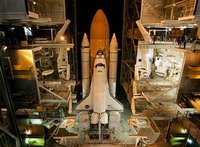Shuttle Discovery and crew of seven launched into orbit for formidable construction job
Space shuttle Discovery and a crew of seven rocketed into orbit as international space station needs a formidable construction job.

Discovery blasted off at 11:38 a.m. (1538 GMT), ducking through clouds. It carried a giant Tinkertoy-type link that must be installed at the space station before European and Japanese laboratories can arrive.
Despite a forecast calling for rain right at launch time, the weather ended up cooperating. And a chunk of ice on plumbing between the external fuel tank and Discovery - 4 inches by 1½ inches (10.2-centimeter by 3.8-centimeter) - was deemed too small by NASA to pose a serious launch hazard. It appeared to be melting as the countdown entered its final minutes.
Launch director Mike Leinbach wished the crew good luck and Godspeed just before liftoff.
"We're ready to take Harmony to her new home," replied commander Pamela Melroy, referring to the new space station compartment aboard Discovery.
Discovery's crew includes an Italian astronaut making his first spaceflight, Paolo Nespoli.
"It's nice to be in space," Nespoli radioed minutes after reaching orbit.
Discovery's fuel tank was modified following the last mission to prevent dangerous ice buildup from the super-cold liquid hydrogen and oxygen, and reduce the potential for launch debris. The patch of ice that had NASA scrambling less than two hours before launch cropped up on a pipe that carries the hydrogen from the tank into the shuttle, and was stuck mostly to a baggy material. It appeared to harmlessly break loose at the moment of liftoff, as NASA suspected it would.
At least six pieces of foam insulation fell off the fuel tank during liftoff, but it was well past the crucial first two minutes and therefore posed no risk to Discovery, said Bill Gerstenmaier, NASA's space operations chief.
The shuttle wings, however, were not altered in any way, even though a safety engineering group pressed for a delay because of concern over three panels with possible flaws.
Melroy, only the second woman to lead a shuttle mission, expressed her confidence late last week about flying Discovery, as have many of the senior managers who decided to skip wing repairs. A possible cracking problem with the protective coating on three of the wing panels was deemed an acceptably low risk.
A hole in the wing brought down Columbia in 2003, the result of a strike by a slab of fuel-tank foam insulation at liftoff.
Discovery and its crew are embarking on a two-week mission that is considered the most challenging and complex in the nine years of orbital assembly of the international space station.
The shuttle is carrying up an Italian-built live-in compartment, about the size of a small bus, that the astronauts will attach to the space station. The name Harmony was the choice of schoolchildren who took part in a national competition. About 130 of those youngsters traveled to Cape Canaveral to witness the launch.
Also on hand for the launch was "Star Wars" director and writer George Lucas. Packed aboard Discovery is the lightsaber used by the character Luke Skywalker in 1983's "Return of the Jedi" to mark the 30th anniversary of the first "Star Wars" film.
Europe and Japan's laboratories will link up with Harmony once they are launched by shuttles over the next few months. The European lab, named Columbus, is targeted for a Dec. 6 launch. Discovery's on-time departure Tuesday kept the Columbus mission on track.
"Congratulations everybody. The beans are on," an animated Leinbach told his team once Discovery safely reached orbit. NASA has a postlaunch tradition of celebrating with beans and cornbread.
"Let's get on to the next launch in December," said Christopher Scolese, NASA's No. 2 man.
After they arrive at the space station on Thursday, Discovery's astronauts also will move a massive girder and set of solar wings from one part of the orbiting complex to another. That work will involve extending radiators as well as the folded solar wings - 240 feet (73.2 meters) from tip to tip when outstretched.
In all, five spacewalks are planned, four to complete this construction job and one to test a method for fixing damaged shuttle thermal tiles using a caulking gun and high-tech goo. The demonstration with sample tiles was added after Endeavour suffered a gouge to its belly during the last launch in August from a piece of flyaway fuel-tank foam.
Once Discovery leaves, the three space station residents - one of whom will be dropped off by the shuttle - will face even more construction work to prepare for the European lab's arrival. Astronaut Clayton Anderson, who will return to Earth aboard Discovery after a five-month station stay, shook a white towel and did a backflip after watching the launch live on a computer.
Subscribe to Pravda.Ru Telegram channel, Facebook, RSS!


